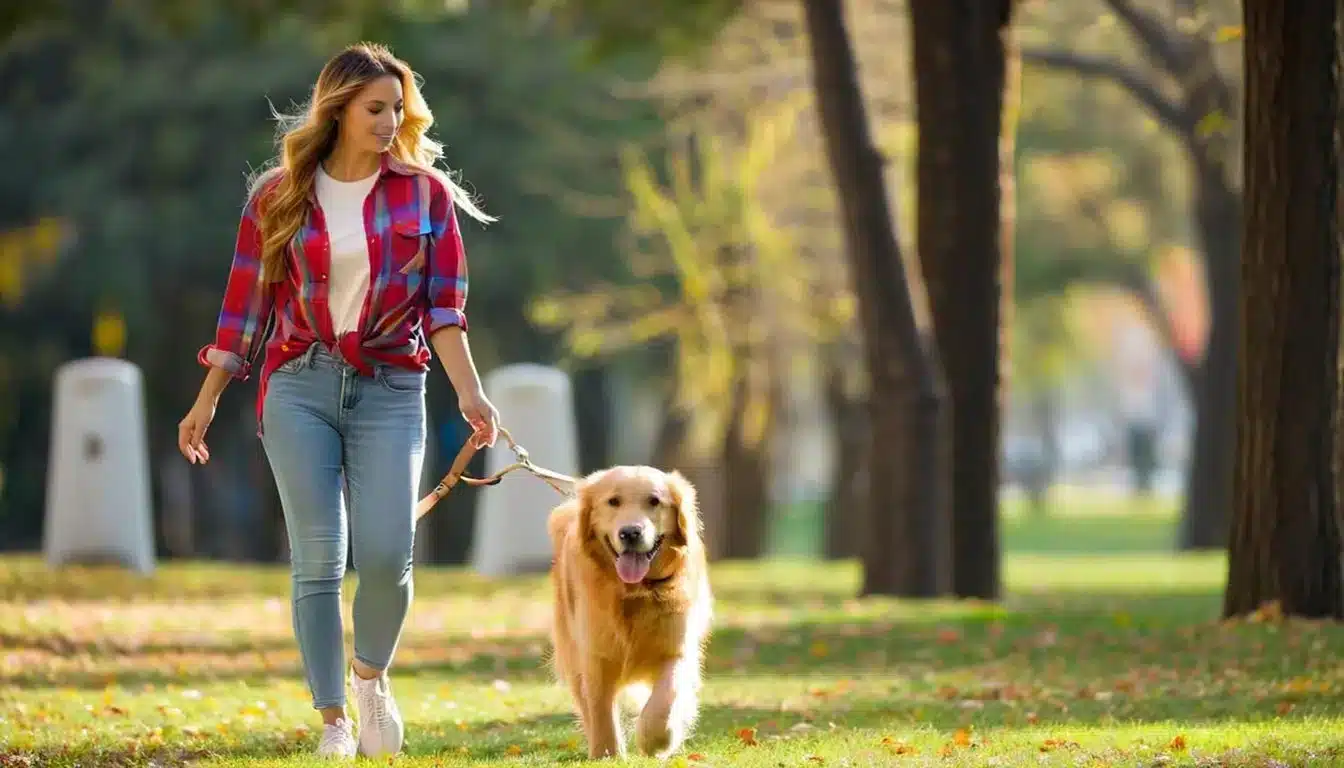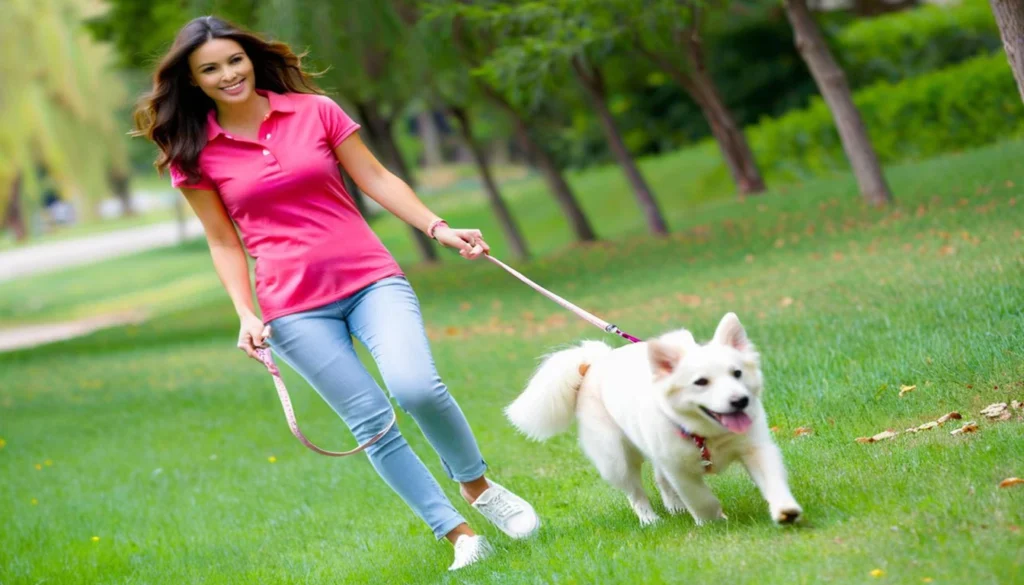Every dog walk used to be a battle until I learned to teach my dog to heel. No more pulling or zigzagging. Now, our walks are peaceful and strengthen our bond.
Teaching your dog to heel is about more than control. It's about building trust and respect. Anyone can do it with patience and practice.
In this guide, I'll share effective techniques for teaching your dog to heel. These methods work for dogs of all ages and personalities. They'll make your walks better, whether you have a puppy or an older dog.
Key Takeaways
- Heel training builds stronger communication between you and your dog
- Consistent practice is crucial for successful heel training
- Positive reinforcement works better than punishment
- Every dog can learn to heel with the right approach
- Heel training improves overall obedience and walking experience
Understanding the Heel Command: A Foundation for Controlled Walking
Dog training is all about clear communication. The heel command is key for harmony between you and your dog. It teaches control and respect during walks.
Experts say the heel command is a special walking way. Your dog stays close to you. It's more than just walking; it's a way to talk to each other.
What Does Heel Position Mean for Your Dog
Teaching your dog to heel means a few things:
- They stay close to your side
- They keep up with your pace
- They watch your movements
- They ignore distractions
The Traditional Left-Side Heel Position
In traditional training, your dog walks on your left side. They stay a certain distance from your leg. This comes from military and working dog training.
Benefits of Teaching Your Dog to Heel
Teaching your dog to heel has many benefits:
- It makes walks safer
- It helps control in crowded places
- It strengthens your bond
- It improves obedience
Mastering the heel command lays the groundwork for more advanced training. It also helps you understand your dog better.
Essential Equipment and Training Tools for Success
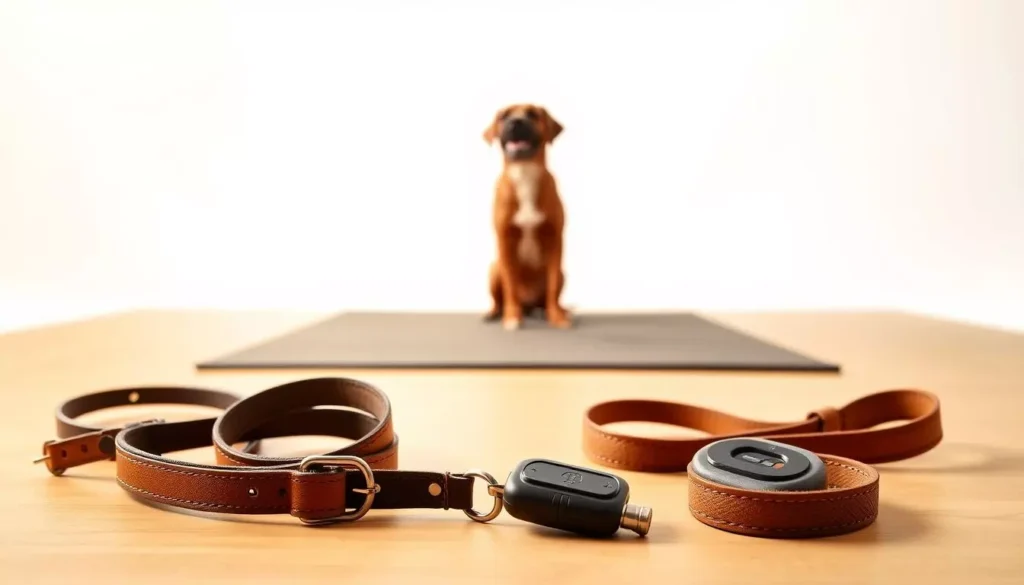
Getting ready for heel dog training means you need the right tools. The right equipment helps you train your dog well. Let's look at what you'll need to start training your dog to heel.
- High-Quality Treats: The most critical tool in heel dog training is a selection of irresistible rewards.
- Clicker for precise behavior marking
- Appropriate training leash
- Comfortable training environment
Choosing the right treats is key for keeping your dog motivated during training. Look for small, soft treats that can be eaten quickly. This lets you keep training without breaks.
| Training Tool | Purpose | Recommended Type |
|---|---|---|
| Treats | Motivation and Reward | Small, soft, high-value treats |
| Clicker | Behavior Marking | Professional training clicker |
| Leash | Control and Guidance | 4-6 foot standard training leash |
"The right tools make heel dog training not just possible, but enjoyable for both you and your dog."
A clicker is a great tool for training your dog to heel. It gives a clear signal when your dog does the right thing. Use the click with a treat to make good behavior rewarding.
Choosing the right leash is important for heel dog training. A 4-6 foot leash is perfect. It lets you guide your dog while giving them enough room to move comfortably.
Preparing Your Dog for Heel Training
Training a dog to heel needs careful preparation and the right approach. Start by creating a great learning environment for your dog. This will help them succeed in heel training.
Begin teaching your dog to heel in a quiet, low-distraction place. Your home is a great starting point. A big room or hallway is perfect for practicing without distractions.
Choosing the Right Training Environment
Look for a space that meets these key criteria for heel training:
- Quiet indoor space with minimal distractions
- Enough room to walk in a straight line
- Comfortable temperature and lighting
- Familiar surroundings for your dog
Setting Up for Proper Positioning
Positioning is key in heel training. Choose one side (usually the left) and stick with it. Stand straight and have your dog sit next to you in the heel position.
Getting Your Dog's Attention and Focus
It's important to capture your dog's attention for heel training. Use these methods to keep their focus:
- Call your dog's name softly
- Hold a treat near your chosen heel side
- Use a calm, encouraging tone
- Make eye contact to establish connection
Pro tip: Short, frequent training sessions work best. Aim for 5-10 minute practices to keep your dog engaged and prevent frustration.
How to Teach Your Dog to Heel: Step-by-Step Guide
Teaching your dog to heel makes walking better and more fun. It's all about being patient and consistent.
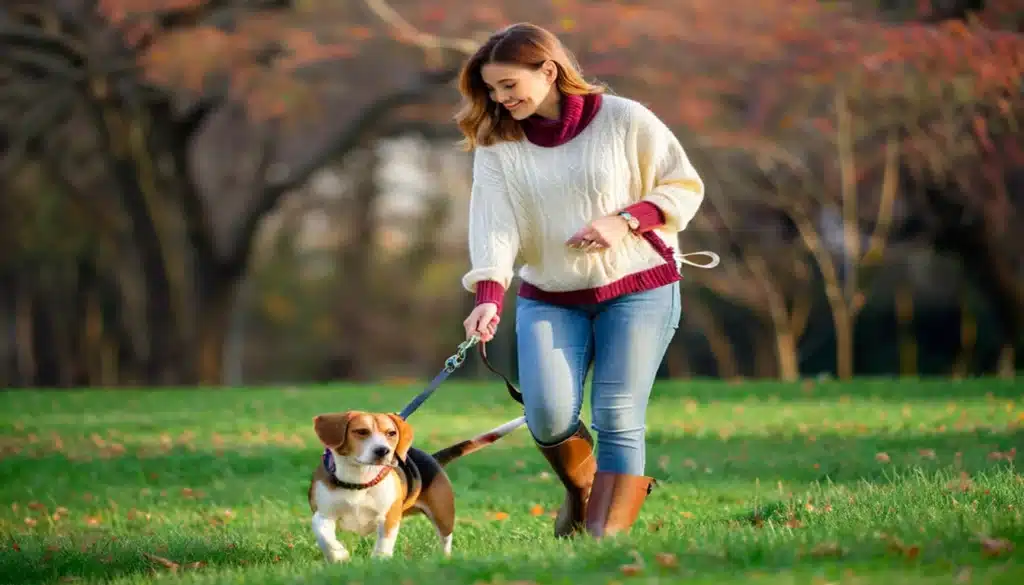
Here's how to teach your dog to heel in simple steps. These steps work for dogs of all ages and types:
- Start in a quiet, distraction-free environment
- Use a short leash for better control
- Hold high-value treats near your left hip
- Begin with short training sessions (5-10 minutes)
The main idea is to make heel position a good thing. Reward your dog right away when they naturally come to your side. Use a clicker or say "yes" to mark the right behavior.
"Consistency is key in heel training. Your dog learns through clear, repeated signals."
Follow this sequence:
- Call your dog to your side
- Mark the correct position
- Reward with a treat
- Take a few steps together
- Repeat and gradually increase duration
| Training Stage | Focus Area | Duration |
|---|---|---|
| Initial Training | Position Recognition | 5-10 minutes |
| Intermediate | Walking in Heel | 10-15 minutes |
| Advanced | Distraction Resistance | 15-20 minutes |
Every dog learns at their own pace. Some get heel training fast, while others need more time. Always be patient and end on a positive note.
Using Positive Reinforcement in Heel Training
Positive reinforcement makes heel training fun and a great way to bond with your dog. It's key to know how rewards work for successful training.
To train your dog well, create a positive and motivating space. The right methods make heel training exciting and strengthen your bond.
Timing Your Rewards Effectively
Timing rewards right is key in heel training. Reward your dog the moment they get it right. This shows them what action gets a treat.
- Reward within 1-2 seconds of the desired behavior
- Use a consistent marker like a clicker or verbal praise
- Keep rewards small and quick to maintain training momentum
Choosing the Right Treats and Rewards
Pick treats that really excite your dog during training. The right rewards can greatly improve your success.
| Treat Type | Motivation Level | Training Effectiveness |
|---|---|---|
| Soft, small treats | High | Excellent for quick consumption |
| Freeze-dried meat | Very High | Keeps dog engaged |
| Cheese bits | High | Good for picky eaters |
Clicker Training for Precision
Clicker training is a precise way to communicate with your dog. The sharp sound marks correct behavior clearly, making training better.
"The click is faster and more precise than verbal praise, creating crystal-clear communication with your dog." - Professional Dog Trainer
Consistency and patience are crucial in teaching your dog to heel. Keep each session short, positive, and end on a high note.
Common Challenges and Solutions in Heel Training
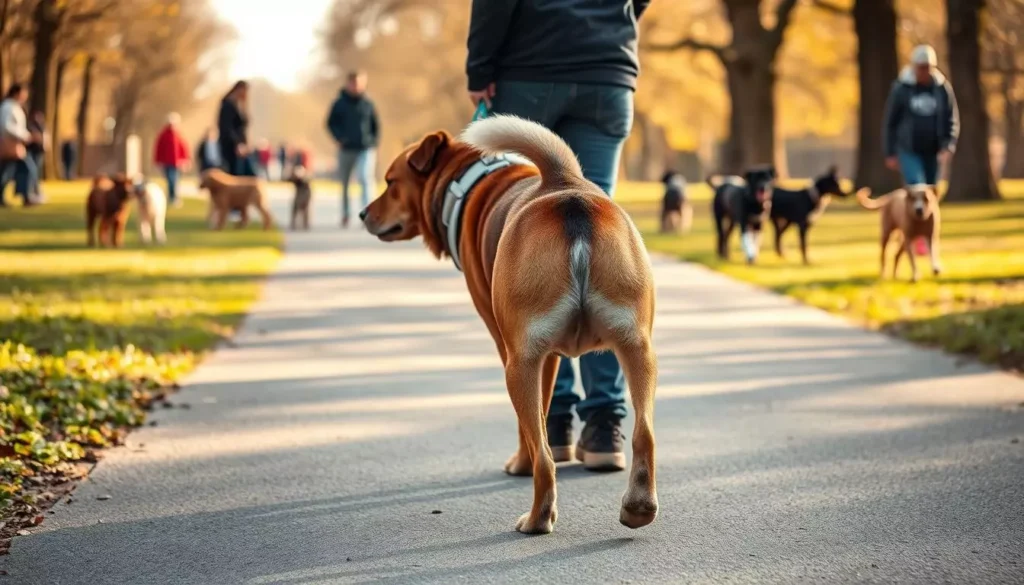
Teaching a dog to heel can be tough, even for seasoned owners. You'll face certain hurdles that need patience and smart strategies.
The main hurdles in teaching a dog to heel include:
- Persistent pulling on the leash
- Getting distracted by environmental stimuli
- Inconsistent performance during training
- Lack of focus during walking
Each problem needs a special solution. Pulling behavior can be fixed by stopping right away when your dog pulls. Then, wait for them to get back into the correct position. This shows them pulling doesn't speed up the walk.
| Challenge | Solution Strategy |
|---|---|
| Leash Pulling | Stop walking, wait for dog to return to heel |
| Distraction | Use high-value treats, practice in low-stimulus environments |
| Inconsistent Performance | Regular short training sessions, positive reinforcement |
Keeping calm and consistent is key when tackling these issues. Every dog is different, so what works for one might not work for another.
Patience and persistent practice are the keys to successful heel training.
Advanced Techniques for Off-Leash Heeling
Teaching your dog to heel off-leash is more than just basic leash training. It's about reaching a high level of obedience and trust. This skill needs patience, regular practice, and understanding your dog's behavior.
Transitioning from Leash to Off-Leash
To teach your dog to heel without a leash, start in a safe place. Use a long training lead and give more freedom as your dog learns. Important steps include:
- Practicing in a securely fenced area
- Maintaining consistent verbal cues
- Rewarding immediate compliance
- Gradually reducing physical guidance
Building Distance and Duration
Off-leash heeling needs to get better over time. Start with short distances and increase them as your dog gets better. Use treats and praise often to keep them on track.
Proofing in Different Environments
The real test of off-leash heeling is in different places. Practice in various settings, like:
- Quiet neighborhood streets
- Local parks with few people
- Areas with some distractions
Remember, safety is key. Always check local leash laws and make sure your dog is reliable before walking off-leash.
Incorporating Heel Training into Daily Walks
Teaching a dog to heel is more than just a skill for special times. It's a constant process that needs to be part of daily walks. Real-world practice makes theoretical training come to life.
To succeed in heel training, you need a smart plan for daily walks. Set clear rules and make walking a chance to learn. Here are some tips to make heel training a part of your walks:
- Begin with short heel segments during walks
- Gradually increase heel duration as your dog improves
- Use varied walking environments to challenge your dog's skills
- Reward consistent heel performance with brief exploration breaks
My method is to make heel training a natural part of walking. Alternate between structured heel positioning and relaxed walking. This keeps your dog from feeling trapped while keeping them disciplined. Remember, being consistent is more important than being perfect.
For better heel training, use verbal cues, keep a steady pace, and practice in different places. Turning walks into training sessions helps your dog learn heel quickly.
"The most effective heel training happens when it feels like a natural interaction, not a strict exercise."
Patience and positive feedback are key to a good heel. Every walk is a chance to grow closer and communicate better with your dog.
Training Variations for Different Dog Breeds and Temperaments
Heel dog training isn't a one-size-fits-all approach. Every dog is unique, needing tailored training strategies. Knowing your dog's breed and temperament is key to teaching them to heel well.
Different breeds react differently to heel training. High-energy dogs like Border Collies or Australian Shepherds need dynamic training. On the other hand, laid-back breeds like Bulldogs might need gentler methods.
- High-Energy Breeds: Use frequent movement and shorter training sessions
- Calm Breeds: Focus on precision and sustained attention
- Independent Breeds: Implement stronger motivation techniques
Dogs with strong personalities need patience and consistent positive reinforcement. Adjust your training style to fit your dog's learning pace and motivation.
"The key to successful heel training is understanding your dog's unique personality and working with their natural tendencies." - Professional Dog Trainer
Some breeds need more repetition or special rewards. Working dogs often learn heel commands faster because they love to please and work with their handlers.
Successful heel dog training is about understanding your dog's needs, being consistent, and celebrating small wins along the way.
Troubleshooting and Maintaining Progress
Training your dog to heel can be tough, even after you see progress. Every dog training journey has its ups and downs. It's important to be patient and solve problems strategically.
- Break down complex commands into smaller, manageable steps
- Practice shorter walking distances initially
- Use high-value treats for motivation
- Recognize and reward incremental improvements
Addressing Pulling and Distraction Issues
Pulling is a common issue in heel training. To fix it, change your pace, use verbal cues, and stop when pulling happens. Being consistent teaches your dog to walk beside you without pulling.
Maintaining Consistency in Training
Regular training keeps skills sharp. Short, frequent training sessions work better than long, rare ones. Practice heel commands in different places to help your dog learn everywhere.
When to Seek Professional Help
If you've tried many ways and still face problems, get help from a professional dog trainer. They can spot specific issues and give you a plan to train your dog to heel well.
Conclusion
Learning to teach your dog to heel is more than a training trick. It's about creating a strong bond with your dog. We've looked at key strategies that make walks smooth and enjoyable. The heel command is a powerful way to talk to your dog, building respect and understanding.
Patience is crucial when teaching your dog to heel. Each dog learns at their own speed. The methods we've talked about, like positive reinforcement, help you succeed. Every little bit of progress is important, and your hard work will pay off.
The skills you've learned go beyond just walking. They make your bond stronger, improve communication, and make life with your dog better. By mastering the heel command, you're not just teaching a trick. You're building a lifelong friendship.
Keep practicing and stay positive. Your dog wants to learn and be close to you. The heel command is a great way to show that connection. Enjoy the journey, celebrate small wins, and cherish the bond you're building with your dog.

